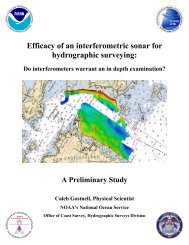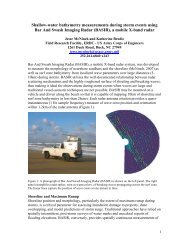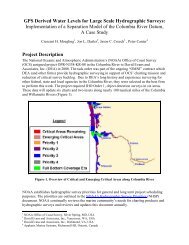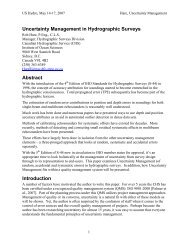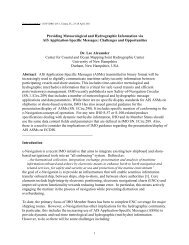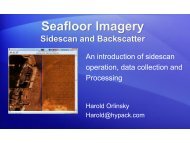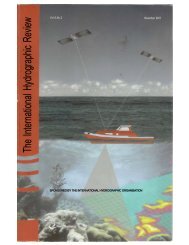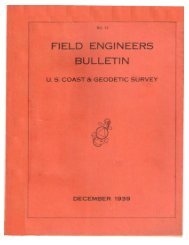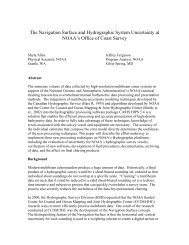AIS Binary Message updates - The Hydrographic Society of America
AIS Binary Message updates - The Hydrographic Society of America
AIS Binary Message updates - The Hydrographic Society of America
Create successful ePaper yourself
Turn your PDF publications into a flip-book with our unique Google optimized e-Paper software.
US Hydro conference 2011 – Tampa<br />
Ted Read MRIN (Presenter)<br />
Managing Director - Ohmex Ltd<br />
9 Gordleton Business Park<br />
Lymington , SO41 8JD, UK<br />
ted@ohmex.com<br />
<strong>AIS</strong> <strong>Binary</strong> <strong>Message</strong> <strong>updates</strong><br />
IMO SN.1/Circ.289 and IMO SN.1/Circ.290 review<br />
Abstract<br />
This short presentation is a review, from a commercial perspective, <strong>of</strong> the recent changes to the<br />
transmission <strong>of</strong> information by way <strong>of</strong> <strong>AIS</strong> binary messages. <strong>The</strong> changes introduced by IMO<br />
SN.1/Circ 289 and Circ.290 are reviewed and the implications for s<strong>of</strong>tware used to decode and<br />
present the embedded message data to the <strong>AIS</strong> user. Ohmex is a manufacturer <strong>of</strong> <strong>AIS</strong> tide and<br />
weather equipment so particular attention is given to the ‘TideMet’ binary message used to<br />
transmit current Tide and Weather information. <strong>The</strong> topic is <strong>of</strong> particular interest to VTS<br />
authorities for the safe navigation relating to ports and harbours using ECDIS equipment. <strong>The</strong><br />
presentation includes data from a recent survey <strong>of</strong> the use <strong>of</strong> these messages and considers the<br />
reason why a fundamental standard navigation message has not, as yet, been adhered to on a<br />
regional or global basis.<br />
Fig 1 - TIDEMET HARDWARE LAYOUT<br />
IMO SN.1/Circ.289 and Circ.290 review Page 1
US Hydro conference 2011 – Tampa<br />
<strong>Binary</strong> <strong>AIS</strong> <strong>Message</strong>s<br />
<strong>Binary</strong> messages contain digital data transmitted and received using standard <strong>AIS</strong> equipment. <strong>The</strong><br />
intention <strong>of</strong> these messages is to reduce verbal communications, enhance reliable information exchange<br />
and reduce VTS operator workload. <strong>AIS</strong> <strong>Binary</strong> <strong>Message</strong>s may be either addressed (point to point) or<br />
broadcast to all listeners. Static Aid to Navigation stations (AtoNs) are designed to report navigation<br />
information, current conditions and warnings together with optional binary messages.<br />
<strong>The</strong> generalized structure <strong>of</strong> an <strong>AIS</strong> message consists <strong>of</strong> a header and data packet encoded as readable<br />
text characters then transmitted in recognizable NMEA format. <strong>The</strong> decoded header contains unique<br />
parameters <strong>of</strong> registration, current location and time together with message specific codes and data. <strong>The</strong><br />
primary message identifier is always „8‟ with the size and structure <strong>of</strong> its embedded data defined by the<br />
Designated Area Code (DAC) and Function Identifier (FI) parameters within the header. Mathematically<br />
this provides for the combination <strong>of</strong> 1023 possible DAC values each with 63 possible FI codes, it would<br />
appear these should provide sufficient combinations for all possible requirements <strong>of</strong> binary messages.<br />
Event History<br />
Fig 2 - TYPICAL TIDEMET BINARY MESSAGE<br />
In May 2004 the IMO Maritime Safety Committee approved SN.1/Circ.236 as guidance for the<br />
application <strong>of</strong> <strong>AIS</strong> binary messages. <strong>The</strong> purpose <strong>of</strong> this document was to define a provisional set <strong>of</strong> 7<br />
digital messages, including the TideMet message, for a trial period <strong>of</strong> 4 years with no change. <strong>The</strong> criteria<br />
for selecting the trial messages were to be a demonstrated operational need by a cross-section <strong>of</strong> users<br />
including ships, VTS, Pilots, Coastguard and port authorities.<br />
<strong>The</strong>se 7 trial messages were reviewed during 2009 and published as 15 new messages within IMO<br />
SN.1/Circ.289, these new messages were defined and approved for international from June 2010. Prior<br />
messages, defined by Circ.236, were revoked with a caveat their use is to cease as <strong>of</strong> 1 st January 2013.<br />
Also in June 2010 the IMO SN.1/Circ.290 was released with the title “Guidance for the presentation and<br />
display <strong>of</strong> <strong>AIS</strong> Application-specific message information”. <strong>The</strong> document was consultative and showed<br />
various suggestions <strong>of</strong> how some binary data might be presented to the user.<br />
IMO SN.1/Circ.289 and Circ.290 review Page 2
US Hydro conference 2011 – Tampa<br />
Changes to TideMet <strong>Message</strong><br />
Fig 3. PREVIOUS TIDEMET HEADER - Circ.236 (121bit)<br />
Function Identifier FI has changed from 11 to 31<br />
Latitude & Longitude have been swapped around<br />
Position quality bit has been added<br />
Header section changed from 121 to 122 bits<br />
Water level now as 0.01m increments.<br />
Additional spare bits added to message<br />
Overall message size increased from 352 to 360 bits<br />
Consequences <strong>of</strong> message Changes<br />
Fig 4. TIDEMET HEADER CHANGES - Circ.289 (122bit)<br />
Aids to Navigation (AtoN) reprogramming<br />
Decoding/Display s<strong>of</strong>tware now obsolete<br />
<strong>Binary</strong> message restructure, needs two parses<br />
Variance from ITU-R M.1371 standard<br />
IMO SN.1/Circ.289 and Circ.290 review Page 3
US Hydro conference 2011 – Tampa<br />
Recent Survey <strong>of</strong> <strong>Binary</strong> <strong>Message</strong> use<br />
Figure 5 was extracted from a recent survey <strong>of</strong> DAC/FI usage and abbreviated to include just TideMet<br />
type messages, it shows a wide range <strong>of</strong> interpretation <strong>of</strong> the basic concept. ITU-R M.1371-4 defines the<br />
use <strong>of</strong> the DAC (country) code within the Application ID, this implies that FI codes are country specific<br />
and that every nation could define their own parochial use <strong>of</strong> these values. <strong>The</strong> DAC country code is also<br />
duplicate information, already contained within the registration number (MMSI) portion <strong>of</strong> the message<br />
header.<br />
Fig 5. *EXTRACT FROM A SURVEY OF DAC/FI TIDEMET USAGE<br />
As can be seen from the table above there is a wide interpretation <strong>of</strong> the use <strong>of</strong> the DAC/FI code to define<br />
the specific application. <strong>The</strong> problem tends to be either historic (St Lawrence Waterway were pioneers <strong>of</strong><br />
the use <strong>of</strong> <strong>AIS</strong> binary messages) or hardware specific where manufacturers have embedded their own<br />
encoding to solve a problem without adhering to the IMO standards. To address this problem the Radio<br />
Technical Commission for Maritime Services (RTCM) is preparing a standard for the use <strong>of</strong> these binary<br />
messages particularly for Inland waterway applications. <strong>The</strong> International Association <strong>of</strong> Lighthouse<br />
Authorities ( IALA) are also in the process <strong>of</strong> compiling a register <strong>of</strong> regional applications for <strong>AIS</strong> binary<br />
messages to prevent duplication <strong>of</strong> effort.<br />
IMO SN.1/Circ.289 and Circ.290 review Page 4
US Hydro conference 2011 – Tampa<br />
IMO SN.1/Circ.290 - Data display formats<br />
Further to work by CCOM-JHC the illustrations in Circ.290 <strong>of</strong>fer some suggestions for presenting<br />
TideMet data to the user, as with all presentations the style is one <strong>of</strong> preference and weighted to specific<br />
requirements. <strong>The</strong> output is normally required in a simple alphanumeric format for instantaneous<br />
readings, in a spatial chart context for navigational needs and preferably in a graphic time series<br />
presentation for a temporal view <strong>of</strong> the data.<br />
Fig 6. EXAMPLE PRESENTATION OUTPUT FOR CIRC.236/289 MESSAGES<br />
IMO SN.1/Circ.289 and Circ.290 review Page 5
US Hydro conference 2011 – Tampa<br />
<strong>Hydrographic</strong> Applications<br />
<strong>The</strong> International <strong>Hydrographic</strong>al Organisation (IHO) is currently investigating a universal standard for<br />
transmitting Tide data for live use by survey vessels. <strong>The</strong> transmission <strong>of</strong> this data by <strong>AIS</strong> has the<br />
advantage that it is available to anyone with a low cost <strong>AIS</strong> receiver within a 25Km range. <strong>The</strong> tide data<br />
supplied is also accurately located and synchronised to GPS time. Hypack s<strong>of</strong>tware has the ability to<br />
decode <strong>AIS</strong> messages and display vessels in the survey vicinity, Ohmex have recently supplied trial data<br />
transmitted using the new Circ.289 message to Hypack who have written a DLL driver for their popular<br />
hydrographic survey package to use the tide data and display the new message parameters.<br />
Other Environmental messages<br />
Fig 7. HYPACK IMPLEMENTATION OF IMO SN.1/CIRC.289<br />
In addition to the TideMet message, Circ.289 also defined binary message 26 which has some 16 short<br />
sub-messages which can contain some <strong>of</strong> the TideMet parameters. <strong>The</strong> requirement for binary messages<br />
on inland waterways is slightly different to coastal areas, some waterways are tidal while others are rivers<br />
or canals controlled by locks and levies. Of particular navigation interest is forward knowledge <strong>of</strong> lock<br />
openings and any awaiting traffic. In addition to under keel clearance, provided by the current water<br />
elevation, inland waterway skippers are interested in „air gap‟ clearance information pertinent to<br />
approaching bridges and overhead structures. <strong>The</strong> Environmental sub-messages defined within Circ.289<br />
using DAC code 200 (Inland) are better suited to these inland waterway requirements rather than using<br />
the TideMet message. <strong>The</strong> inclusion <strong>of</strong> the Area message 22 within the revised list <strong>of</strong> broadcasts provides<br />
the possibility <strong>of</strong> placing a temporary AtoN on drifting obstacles such as Icebergs. This would mark their<br />
current position and also give an indication <strong>of</strong> their speed, heading and danger area by transmitting a zone<br />
<strong>of</strong> influence. <strong>The</strong> AtoN device could be a buoy device dropped on an Iceberg and recovered at a later date<br />
when the hazard to navigation has melted away. Some work would need to be done on differentiating a<br />
floating AtoN from one riding on an Iceberg, however, there are sufficient parameters in existing binary<br />
messages to accommodate these specific requirements.<br />
IMO SN.1/Circ.289 and Circ.290 review Page 6
US Hydro conference 2011 – Tampa<br />
Satellite <strong>AIS</strong> Applications<br />
Satellite networks such as Orbcomm have onboard VHF receivers which can track <strong>AIS</strong> transmissions<br />
within their footprint, coupling these together on their control network produces a global view <strong>of</strong> <strong>AIS</strong><br />
traffic. <strong>The</strong> following images show a snapshot <strong>of</strong> the <strong>AIS</strong> targets seen within the Indian Ocean over a<br />
short selected time period.<br />
Fig 8. ORBCOMM <strong>AIS</strong> TRACKING OF INDIAN OCEAN AREA<br />
In addition to vessel traffic the Orbcomm network can also collect binary messages from AtoN<br />
transmissions. <strong>The</strong>re is a potential use for this wide area <strong>of</strong> AtoNs viewed by the network to be <strong>of</strong> use for<br />
tracking or even the prediction <strong>of</strong> impending events such as impacts <strong>of</strong> a Tsunami wave. <strong>The</strong> latency <strong>of</strong><br />
messages in networks like Orbcomm is small enough to actually enable prediction and warning <strong>of</strong><br />
landfall by a large wave by up to 4 hours before the impact. A remote AtoN would probably be shore<br />
based or in a shallow water mooring enabling its tide gauge to detect the relatively large amplitude, slow<br />
moving wave as opposed to false triggering by the very fast moving, small amplitude deep ocean waves<br />
monitored by floating wave sensors.<br />
Future requirements<br />
Security - Of great concern to port and coastal authorities is the potential hazard <strong>of</strong> a rogue AtoN which<br />
is transmitting false information and cannot be deactivated remotely. <strong>The</strong>re is a requirement for not only<br />
an addressed control message but also some form <strong>of</strong> security password/verification to prevent<br />
unauthorised „hacker‟ access to the remote device.<br />
Website information - As the potential bandwidth <strong>of</strong> <strong>AIS</strong> is limited the possibility <strong>of</strong> transmitting more<br />
detailed information to a vessel <strong>of</strong> say the latest ECDIS chart information for a port would be severely<br />
restricted. A suggestion would be to embed a URL within an AtoN message, this could then be accessed<br />
via the Internet obtaining more detailed information relevant to the location. <strong>The</strong> alternative would be an<br />
addressed message requesting further information from a VTS base station including URLs pointing to<br />
further information such as a port‟s website. This mechanism would in effect make <strong>AIS</strong> part <strong>of</strong> a larger<br />
„Mesh‟ based computer network that would link <strong>AIS</strong>, BGAN, WiMax and cellular networks.<br />
IMO SN.1/Circ.289 and Circ.290 review Page 7
US Hydro conference 2011 – Tampa<br />
Conclusions ...<br />
Incorporation within the ECDIS standard - By changing the underlying binary message<br />
layout the update has rendered as useless existing s<strong>of</strong>tware written to decode and display the<br />
previous message. To add to the problem it is also difficult for s<strong>of</strong>tware to discern that a device is<br />
transmitting the old or new message format, backward compatibility between messages has<br />
become an issue. If the new TideMet message was incorporated within the ECDIS standard for<br />
chart display then all new s<strong>of</strong>tware would incorporate the format as standard.<br />
Dual message decode - Until the expiry date in 2013 any adopted s<strong>of</strong>tware standard for<br />
displaying the TideMet message should attempt to decode the new message first before<br />
attempting the older message.<br />
Expand on graphic display format – As suggested in IMO Sn.1/Circ.290 there should be a set<br />
<strong>of</strong> display formats adopted for presenting the TideMet information in graphic form in addition to<br />
alphanumeric text. <strong>The</strong> TideMet message makes use <strong>of</strong> non-SI combination <strong>of</strong> units (Miles,<br />
Knots etc) so these displays should be in user selected unit preference (i.e. feet/meters etc).<br />
Similarly the use <strong>of</strong> language filters for the titles and descriptions used should form part <strong>of</strong> any<br />
standard for presentation.<br />
Range and accuracy Water Level – <strong>The</strong> new message has overcome the previous limit on<br />
Water Level resolution from 0.1m to 0.01m. Unfortunately it has parted from the <strong>AIS</strong> standard<br />
for 2‟s compliment numbers by having a constant <strong>of</strong>fset <strong>of</strong> -10.0m.<br />
Harmonize Inland/Coastal usage – As yet there is no clear distinction between the specific<br />
requirements <strong>of</strong> maritime and inland waterways usage <strong>of</strong> DAC/FI codes, or even the overlap<br />
between their two areas <strong>of</strong> message use. Standardization <strong>of</strong> message requirements and the<br />
introduction <strong>of</strong> an application register are now an urgent requirement to enable further s<strong>of</strong>tware<br />
and equipment development.<br />
Subjective or derived values - Many <strong>of</strong> the parameters defined in the IMO TideMet standard<br />
message are subjective so are not suitable for automated instrumentation (e.g. Sea State,<br />
Visibility, Precipitation). Other parameters such as Dew Point and Significant Wave Height are<br />
derived so could be calculated by a client program. A standard calculation <strong>of</strong> derived values<br />
should be formally stated.<br />
IMO SN.1/Circ.289 and Circ.290 review Page 8
US Hydro conference 2011 – Tampa<br />
Acronyms used<br />
<strong>AIS</strong> - Automatic Identification System<br />
AtoN - Aid to Navigation<br />
BGAN – Broadband Global Area Network<br />
CCOM-JHC - Centre for Coastal & Ocean Mapping - Joint <strong>Hydrographic</strong> Centre<br />
GNSS - Global Navigation Satellite System<br />
IALA - International Association <strong>of</strong> Lighthouse Authorities<br />
IMO - International Maritime Organization<br />
IEC - International Electro technical Commission<br />
MMSI - Maritime Mobile Service ID<br />
NMEA - National Marine Electronics Association<br />
R&TTE - Telecommunications Terminal Equipment (R&TTE) Regulations<br />
Reference materials<br />
IMO SN.1/Circ.289 - June 2010<br />
IMO SN.1/Circ.290 - June 2010<br />
New Standards for Providing Meteorological and <strong>Hydrographic</strong> Information via <strong>AIS</strong> - L.Alexander,<br />
K. Schwehr – International <strong>Hydrographic</strong> review, May 2010<br />
Tidal & Meteorological data over <strong>AIS</strong> – E.F.Read, W.S.Heaps – <strong>Hydrographic</strong> <strong>Society</strong>, Hydro8<br />
proceedings, November 2008.<br />
IMO SN.1/Circ.236 - May 2004<br />
Acknowledgements<br />
*Neal Arundale - UK<br />
Pat Sanders, Mircea Neacsu - Hypack Inc - USA<br />
Nick Ward -Trinity Light House Service - UK<br />
Kurt Schwehr - UNH, CCOM - USA<br />
Steve Shipman - IHO - Monaco<br />
Mariuxi Chávez - Orbcomm Inc. - Europe<br />
PRESENTING AUTHOR BIOGRAPHY<br />
Ted Read is managing director <strong>of</strong> Ohmex Ltd, a<br />
UK based manufacturer <strong>of</strong> marine instruments<br />
and application s<strong>of</strong>tware. Born in Bahrain and<br />
educated in London he has been personally<br />
involved with advanced s<strong>of</strong>tware and<br />
electronic design projects for the past thirty<br />
years<br />
IMO SN.1/Circ.289 and Circ.290 review Page 9



